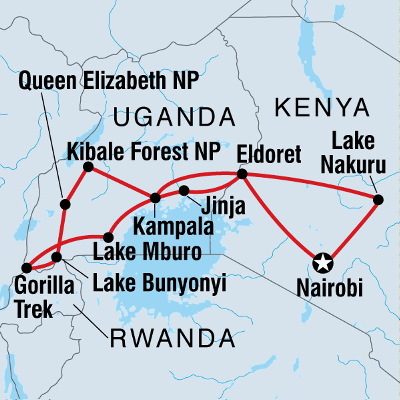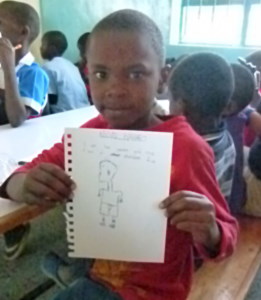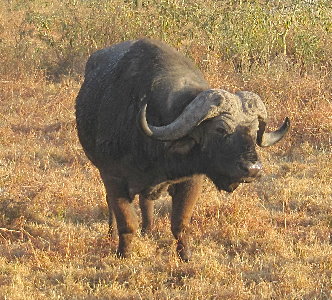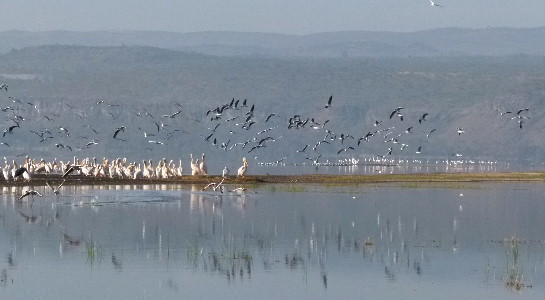From there we headed south ultimately ending in Capetown.

The view from our room of the grounds of the hotel and the city beyond.
We walked to the central business district which could have been mistaken for nearly any city we have visited.
Occasionally there were women wearing traditional clothing.
The Masai market gave us our first look at the handicrafts that could be purchased.
And the first taste of the negotiation that was a part of every purchase.
The next morning we met our guides Jodi and Paul, the rest of our traveling companions and our truck, Claudia.
Claudia was an experienced traveler with many, many miles in her past.
Paul and Jody had just given Claudia a fresh coat of paint and repaired what problems that they could identify and they were ready to go.
We are off.
The great rift valley extends from northern Syria to central Mozambique.
It consists of a series of faults and and rifts that are slowly tearing the African continent apart and separating it from Asia.

Active and inactive volcanoes dot its length.
Facilities were just down the hill from the overlook and provided and introduction to the more rustic life we were about to begin.
Many places along the road we saw markets that seemed to have all the necessities.
We visited an orphanage were the kids drew pictures with supplies that Nancy had brought for just such an occasion.

And sang for us.
I gave some of the kids strings and they taught me some string figures that they knew.
Here is one. I will be posting instructions when I get my string figure page together.
The manager and three of the children as we were saying goodbye.
On to Lake Nakuru National Park for our first sight of wildlife.
This Green Vervet monkey was trying for a handout from the folks in the car ahead of us.
One of his relatives invaded the ranger station and came out dragging a bag of garbage.
These are he first waterbucks we saw.
We saw many here and later in the trip.
Cape buffalo are one of the sub species of African buffalo.
It resembles but is only a distant relative of the Asian water buffalo.
It is the first of the "big five" that we saw.

Impala were everywhere
We were excited when we spotted this reticulated giraffe.
And these Grant's zebras
Baboons.
Some baboons playing in Kenya's Lake Nakuru National Park.
We could have watched them all day.
Unfortunately the light was behind them when they were in the tree so the exposure on this video leaves a lot to be desired.
The view from a rocky overlook in the park.
We could see some wildlife in the fields below.

The rocks were home to hyrax which resemble woodchucks but are relatives of the elephant.
Red-headed Rock Agama lizards and others were there too.
These vervet monkeys weren't as bold as the first ones we saw.
Rhinos, the second of the big five.
These Black Rhinos were just resting in the heat of the day.
And this White Rhino was grazing until he noticed us.
Then he turned and ambled off.
Thomson's gazelle, young, mature and one with some zebras so you can see how small they are.
I don't know what this antelope was other than moving fast.
If you can tell from this picture send a note.
White pelicans, gulls, a heron, a stork, a sacred Ibis, flamingos, and a stilt at the lake.
For pictures of many more birds we saw throughout Africa click here.

The lake is very salty as evidenced by these deposits along the shore.
As we left the park we passed these homes decorated with murals.
Another roadside market.
This one seemed to have nothing but potatoes.
Our first Equator crossing here in Africa, going north.
Many of the roads in Uganda were paved but I have only seen a few dirt roads that had ruts this deep.
Kids on their way to school and some homes.
We started to see rice being grown.
And then a tea plantation.
We also saw sorghum, banana, sugar cane and other crops.
These were the first commercial farms we had seen on the trip.
This roadside market had bananas, melons and some other fruits.
The "facilities" at this rest stop were better than most, relatively clean, with a door, and only smelly not reeking.
A village and market.
The high rent district is up the hill.
AutoZone, Pep Boys Auto Supply, and Advance Auto Parts, Uganda style.
This high class camp had picnic tables.
This billboard is just one of the attempts to curb the population growth that is a source of problems in much of Africa.
One of many opportunities to get to know Claudia's hardware.
This time it was a problem with the clutch slave cylinder that was making gear changes difficult.
We camped at a tea plantation and took a tour that included demonstration of how they pick only the top three leaves on the bush.
A freshly planted cutting and one that has been producing for 50 years.
Some of the plantation fields had grass shelters for guards.
One of the sheds where the tea is stored while waiting to be collected and taken for processing.
Elephant grass is cut and used as mulch around new plantings.
Battery powered cameras, music players and GPS units from many countries required a nest of adapters and cords.
A 1000 watt inverter provided the power.
Small skittish visitors to camp.
We set out from Kanyanchu Visitors Center in Kibale National Park to try to find chimpanzees.
Note the rifle the guide carried.
She assured us that it was to protect us from buffalo or other wild animals.
She had never had to kill any, several times she had fired into the dirt to scare them off.
After an easy walk into the forest we met these cousins
A chimpanzee mother and baby in the tree above us.
On the way back to camp we saw a baboon troop along the road.
We stopped to watch.
As we traveled all the kids smiled and waved.
People lined up at community wells to get clean water.
Then carried it back home.
Children often were carrying as many liters as they were old. 12 years old = 12 liters = 26 pounds.
Crossing the equator southbound in Uganda.
We entered Queen Elizabeth National Park.
Waterbuck were common even before we got the the Katunguru gate on Crater Drive.
We saw these two vying for the favor of a female who was nearby.
And it was soon evident which one won.
Some of us moved up to the open air roof seats at the front and back of the truck for a better view,
even though we had been cautioned to be on the lookout for tree climbing lions in the park
We stopped to watch some elephants cross the road ahead of us.
We actually didn't have much choice, they don't yield the right of way.
We started to go when another one announced his displeasure at us for coming between him and the others.
This cape buffalo also seemed less than happy with us too.
A small herd of waterbuck crossed the road ahead of us.
A warthog family.
These African Long-tailed Shrikes (probably) were common but shy.
Lake Edward forms one boundary of the park.
The barely visible distant shore is the Congo.

Mweya resort in the park is beautifully appointed (not where we stayed).
We did however take a boat ride from there to see even more wildlife.
Viewing began even before we boarded.
And we could see more animals across the Kazinga Channel.
We were soon there.
It is hard to show how many animals we saw here, but this video gives some idea.
Sunset over Lake Albert on our way back to camp.
Guys get together to show off their rides in nearly every town.
We had shopping duty one day so our cook Denford flagged down some guys on motorcycles and we were off to the market a couple of miles away.
Sorry there aren't any pictures of the trip back but it was hard enough to stay aboard while managing to hold our bundles and bags without trying to take a picture.
Our camp at Lake Bunyonyi had a nice restaurant, dugouts, and a beautiful sunset.
We stopped here again on our way back from Rwanda.
I tried a little astrophotography too.
Lunch in Kigali Rwanda and a view of the city.
The Kigali Memorial Center was opened in April 2004, on the 10th Anniversary of the Rwandan Genocide .
The Centre is built on a site where thousands of people are buried under these stone slabs
The names of just a few of them.
This is Hôtel des Mille Collines that was where more than a thousand people took refuge during the Rwandan Genocide of 1994.
It was the basis of the film Hotel Rwanda.
Then on to Parc National des Volcans.

SACOLA (Sabyinyo Community Livelihood Association) dancers performed for us with grace and energy as we were getting ready for our gorilla trek in the in the Parc National des Volcans in Vergunga, Rwanda.
Drumming and dancing.
At the very end you can see that one of the dancers has a baby slung on her back.
We were divided into groups of eight and driven to a village at about 8400 feet elevation.
There we were provided with walking sticks for our climb through fields then into the mountaintop jungle.
After hiking several miles and climbing 1400 feet (425 meters) we were rewarded with a closeup encounter with a family of twelve gorillas.
This silverback posed nicely.
This one and a couple of youngsters were napping together in a pile or just lounging around
They mostly didn't pay attention to us but occasionally one would stare at us as intently as we were at him.
A youngster was picking and eating plants.
While we were watching another he bent over a little too far and tumbled down from the pile of branches he was perched on.
You can see just how close we were to them in this video
After a much too brief hour with them our guide told us we had to leave.
Out of the jungle we stopped to rest and enjoy the view before continuing down through the mountainside fields.
On the road again back to Lake Bunyonyi we saw people lined up at community wells and standing along the road with their water containers.
Homes and kids on the hills.
Rather than ride in the truck over the long rough roads around the lake we hired two boats for a relaxing cruse back to camp.
Along the way we saw several local folks in dugout canoes.
We stopped at a school on our way back.
The classrooms were tiny and overcrowded but the kids were enthusiastically reciting their lessons.
All except for two who may have been sick who slept through our whole visit.
I asked the young man who had started the school why he had done it.
He said that someone had sponsored him when he was a child and this was his way of paying that back.
Lessons and dance.
The schools bus/boat looks more than full but there were still about 10 yet to board.
Back at the camp most all of us went swimming.
And a few took advantage of a very small platform on a very shaky tree for another bit of fun.
A quiet game of Scrabble at the bar.
Some sights as we traveled along.
Ankole or Watusi cattle can be surprising when they wander up when you are relieving yourself at one of the informal stops we made.
Produce and livestock bound for market.
Most towns have speed bumps as you come in.
They have to be big to distinguish regular old bumps we were getting used to.
Typical of most of the shops in this area.
The facilities at our camp at Lake Mburo National Park were less than ideal but we did have some close encounters with wildlife that made it worthwhile.
Getting ready for our guided walking safari.
We saw impalas, zebras, warthogs, topi (classic pose), a hippo (recovering from battle wounds), and waterbuck
There were hundreds of these Grant's Zebras, also known as Common Zebras.
They are a subspecies of the Plains Zebra.
A lion's footprint and a kill from the day before gave us pause.
When we got back to camp we found it had been invaded by very peaceable warthogs.
Many of us were taking pictures of them.
Overnight these hippos wandered through too.
We were warned that before you got out of your tent in the dark you should shine a light around the area.
If you saw red glowing eyes you should just wait for as long as it took for those eyes to go away.
Like most evenings it was dark before we had dinner.
A female bushbuck antelope and baboons.
Some impala were standing along the road.
A few of them then the rest bounded off.
Back across the equator.
Our horseback ride along the Nile took us past villages, schools, gardens, and more wildlife.
A tsetse fly trap along the trail.
They are lured by the smell from a bottle of cow urine and fly toward the blue cloth.
When they land they fall into the trap and die.
Bags of charcoal used for most cooking.
We saw a lot of birds during our excursion on the Nile and several less expected things.
Like this bust of Gandhi where some of his ashes were placed in the Nile as they were in other major rivers of the world.
We also saw a monitor lizard and a black mamba snake about 6 feet long in a tree overhead.
You can see our bird pictures here.
Other activities on the Nile included bungee jumping.
Not for us but four of our companions tried it.
Along the road we often saw the results of serious accidents.
Markets and a wood shops in a town.
A brief stop at a dairy plant to get some ice cream and cheese and check out a little of the processing required.
Raw milk receiving, testing, processing (2 steps shown), sales, and consumption (the best part).
Some papyrus growing at one of the camps.
Wildlife comes in all sizes.
The last evening in camp on the first leg of the tour we all had dinner together and had some fun.
After dinner Jody and Paul were linked by ropes and challenged to escape.
Jody's wrists were tied together and and the same to Paul with the ropes linked together.
Here is one attempt.
They thought they had it solved.
They didn't succeed this time but it is possible.
Back across the Great Rift valley, with storm clouds over one of the mountains.
Time to say goodbye to some of our companions on this leg of the trip.
Others are continuing on south with us and some new folks will be joining.
